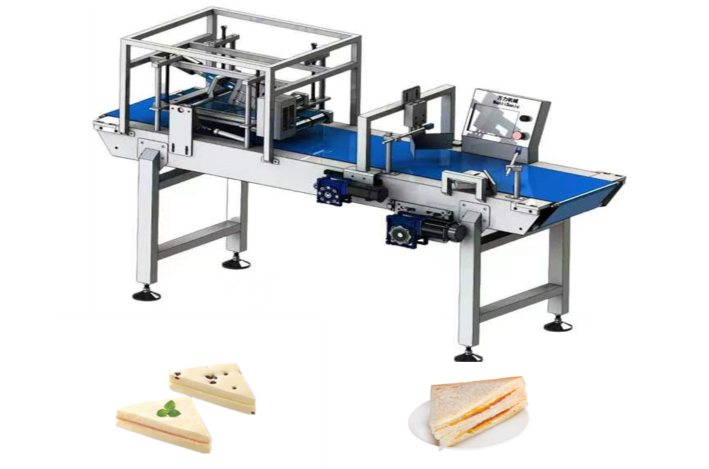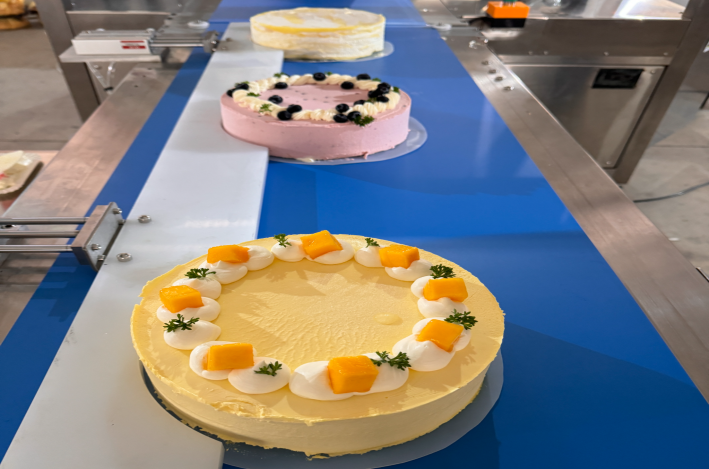Cara Mesin Pemotong Kek Ultrasonik Berfungsi
Memahami mekanisme mesin Pemotong Kek Ultrasonik mendedahkan teknologi canggih di sebalik operasi efisien mereka. Dengan menukar tenaga elektrik kepada getaran mekanikal, mesin-mesin ini menawarkan pemotongan yang tepat dengan kerosakan minima kepada kek-kek halus seperti kek dengan reka bentuk rumit atau tekstur lembut.
Komponen Utama Pemotong Ultrasonik
Roti-roti boleh dipotong kepada bahagian atau berat piawaian menggunakan mesin pemotong kek ultrasonik dengan bantuan beberapa komponen lain. Komponen utamanya ialah transduser yang memindahkan tenaga elektrik kepada getaran mekanikal, yang mana penting untuk proses pemotongan. Penjana mengawal frekuensi ultrasonik dan kuasa gelombang bunyi, yang seterusnya membolehkan mesin beroperasi pada prestasi terbaiknya. Alat pemotong, yang dalam sesetengah kes diperbuat daripada bahan kukuh seperti titanium atau keluli tahan karat, direkabentuk untuk menahan getaran kerap bagi meningkatkan jangka hayat dan ketepatan pemotongannya. Setiap komponen kecil adalah penting untuk mengekalkan keputusan yang konsisten seperti yang dijangka daripada mesin-mesin ini, dan penyertaan mereka merupakan bukti kejuruteraan berkualiti tinggi yang terlibat.
Peranan Getaran Berfrekuensi Tinggi
faktor utama untuk peningkatan kecekapan pemotongan mesin pemotong ultrasonik adalah tindakan getaran berfrekuensi tinggi, yang mengurangkan geseran antara bilah dan kek secara ketara. Pengurangan geseran ini bermakna potongan yang lebih licin lebih mudah dicapai, yang penting supaya tekstur kek dikekalkan dan tidak dipicit atau koyak. Getaran ini juga menghasilkan tindakan 'kavitasi', membolehkan bilah memotong kek yang tebal dengan hampir tiada daya ke bawah, mengekalkan kedudukan kek pada tempatnya. Keputusan kajian menunjukkan bahawa frekuensi ultrasonik, dari 20 kHz hingga beberapa MHz, adalah paling sesuai untuk pemotongan yang cekap sambil mengekalkan ketepatan stabil bagi pelbagai jenis kek. Ketepatan ini meningkatkan rupa barang bakeri dan juga membolehkan operasi seragam di seluruh persekitaran kedai kek, menjadikan mesin pemotong kek moden sebagai sebahagian penting dalam perniagaan.
Elakkan Daya Berlebihan Semasa Pemotongan
Mengapa Tekanan Berlebihan Merosakkan Tekstur Kek
Jika anda memaksa ketika memotong kek, anda akan mendapat keadaan yang tidak kemas, merosakkan tekstur kek anda. Menggunakan tekanan yang terlalu kuat boleh menyebabkan kek menjadi lembik atau berkecai, serta mengurangkan daya tarikannya, rasa, dan teksturnya. Penyelidikan menunjukkan kek mengekalkan struktur asalnya apabila dipotong dengan teliti, menekankan keperluan untuk tetapan mesin yang boleh dilaras berbanding kaedah menggunakan tenaga fizikal. Menggunakan jumlah tekanan yang sesuai akan memastikan tekstur kek tidak rosak dan potongan kelihatan kemas, yang juga merupakan aspek penting dalam hiasan kek.
Melaraskan Tetapan untuk Ketepatan Lembut
MENGAPA KESERDERHANAAN Mesin pemotong kek ultrasonik boleh menyesuaikan kelajuan dan amplitud pemotongan, ia boleh mengubah kelajuan dan amplitud pemotongan kek, serta dipadankan dengan konsistensi dan reka bentuk kek untuk menghasilkan kesan pemotongan yang terbaik. Melatih operator untuk menyesuaikan tetapan ini menghasilkan keputusan yang lebih baik secara keseluruhan, kurang sisa, dan pengurangan masa hentian. Disebabkan ketepatan proses, pemantauan dan kalibrasi tetapan mesin secara berkala adalah penting untuk mengelakkan kesilapan yang boleh menghasilkan tekanan berlebihan, yang pada gilirannya menghasilkan tepi potongan yang bersih dengan kemasan berkualiti tinggi.
Mengekalkan Kebersihan dan Kebersihan Mata Pisau
Risiko Pencemaran daripada Kebocoran Sisa
Adalah penting untuk memastikan bilah-bilah dijaga kebersihannya, kerana kurangnya kebersihan boleh menyebabkan kek melekat pada bilah, yang hampir pasti akan menyebabkan pencemaran. Sisa-sisa ini boleh kekal pada gear pemotong, menempatkan keselamatan makanan dalam risiko. Jurumasak sudah dipengaruhi oleh peraturan makanan yang menghendaki pemeriksaan kerap dan pembersihan intensif, terutama di dapur profesional, di mana makanan diproses dalam kuantiti besar. Fakta-fakta ini menekankan keperluan tersebut, dengan statistik menunjukkan peralatan memasak yang tidak bersih bertanggungjawab ke atas lebih daripada 30% daripada semua penyakit akibat makanan. Penyelidikan yang membimbangkan ini menunjukkan keperluan langkah-langkah ketat dalam pembersihan dan kebersihan bilah bagi melindungi kesihatan awam.
Protokol Pembersihan Langkah demi Langkah
Adalah penting untuk mempunyai rutin pembersihan yang tersusun apabila mengendalikan mesin pemotong kek ultrasonik bagi mengekalkan tahap kebersihan. Prosedur biasa ialah membongkar mesin pemotong untuk mendedahkan setiap bahagian, kemudian membersihkan setiap bahagian dengan air suam dan detergen lembut. Ejen pembersih selamat untuk makanan adalah pilihan yang sesuai bagi penyucian menyeluruh yang juga lembut terhadap komponen presisi. Adalah penting juga untuk mengekalkan jadual pembersihan bagi memastikan kebersihan sentiasa mengikut piawaian. Ini bukan sahaja menunjukkan pematuhan ketat terhadap kod kesihatan, tetapi juga menunjukkan komitmen untuk beroperasi secara selamat dan bertanggungjawab.
Memotong Kek pada Suhu Optimum
Kesan Kek Sejuk atau Hangat terhadap Pengelupasan
Suhu kek adalah penting dalam menentukan tekstur dan hasil potongan. Kek yang sejuk lebih keras, manakala kek yang dingin lebih nipis dan kemas. Ini kerana apabila kek berada dalam keadaan sejuk, ia menjadi lebih tegang, membolehkan anda menghiris atau memotongnya tanpa mengganggu lapisan atau inti di dalamnya. "Manakala kek panas, anda mungkin dapati ia menjadi lembik dan cenderung hancur apabila mula dipotong." Kelunakan dan keanjalan kek apabila dipanaskan tidak akan pernah menghasilkan potongan yang cantik, malah hanya akan menjadi huru-hara yang sukar dihidangkan. Mereka yang arif dalam perkara ini mencadangkan julat suhu tertentu bagi pelbagai jenis kek untuk mendapatkan hasil potongan terbaik. (Sebagai contoh; kek keju; kek buah Massey perlu disejukkan dalam peti sejuk, tetapi beberapa jenis kek span ringan dan berangin lebih fleksibel pada suhu bilik, asalkan tidak terlalu panas atau lembik, dll.)

Garispanduan Pencairan dan Penyejukan Sebelum Menghiris
Tentukan kriteria pendinginan dan pencairan sebelum memotong untuk mendapatkan tekstur dan rupa yang sempurna. Salah satu tip yang kerap dicadangkan ialah menyejukkan kek lembut seperti kek mousse dengan ringan bagi memudahkan pemotongan. Struktur yang diberikan oleh sedikit pendinginan boleh menjadi perkara yang baik; ia dapat mengelakkan kek daripada runtuh atau hilang bentuk. Untuk kek harian, anda perlu mencari julat suhu bilik selama 30-60 minit, yang mengekalkannya mudah dipotong tanpa terlalu padat. Tempoh ini merupakan titik tengah yang ideal kerana kek masih kekal agak tegar (tidak terlalu lembut) tetapi tidak terlalu panas. Dengan mengikuti tip sebelum memotong ini, anda sentiasa dapat mengucapkan selamat tinggal kepada potongan kek yang buruk rupa dan pada masa yang sama menyediakan potongan yang menarik secara visual dan kukuh dari segi struktur, menjadikan penyajian kek serta memberi potongan kek lebih menyenangkan untuk apa jua majlis.
Penyimpanan Kek yang Betul Sebelum Pemotongan Ultrasonik
Pengekalan Kelembapan dan Tekstur yang Ideal
Penyimpanan kek adalah penting untuk mengekalkan kelembapan dan tekstur yang sesuai terutamanya sebelum menggunakan mesin pemotong kek ultrasonik. Menyimpan kek di dalam bekas kedap udara adalah salah satu sebab utama kek kekal lembap — jika dibiarkan terdedah di udara terbuka, kek akan kering dan hilang kelembapan tinggi serta struktur remukan yang padat. Pakar mencadangkan agar bekas ini disimpan di tempat yang sejuk dan kering untuk mengekalkan rasa dan kelembapan kek supaya ia kekal dalam keadaan unggul. Dan, jangan lupa memeriksa kelembapan kawasan penyimpanan. Kelembapan tinggi boleh menyebabkan kek terlalu lembap, manakala kelembapan rendah boleh membuatkan kek menjadi kering. Dengan menilai keadaan penyimpanan, kedai kek boleh memastikan pengalaman yang baik dan sedap.
Mengelakkan Kelalaian Penyimpanan Biasa
Kualiti kek bergantung banyak kepada mengelakkan kesilapan penyimpanan yang paling kerap berlaku. Satu lagi kesilapan biasa ialah menyimpan kek terlalu kedap udara – dibalut rapat dengan bahan yang tidak menyerap udara – menyebabkan kek menjadi lembap dan basah kuyup. Di hujung spektrum yang lain, membiarkan kek terdedah di udara terlalu lama juga boleh menyebabkannya mengeras – dan kering. Keseimbangan adalah penting di sini. Bengkel-bengkel untuk mengajar anda cara memelihara kekApabila tiba masanya untuk memelihara kek, kaedah untuk mengekalkan kesegaran kek seolah-olah dilupakan, bukan? Dan dengan mengelakkan perkara-perkara ini, penjual kek dapat menyediakan kek yang sedap rasanya, lembap, serta mempunyai daya tarikan visual yang penting bagi menghasilkan produk berkualiti.
Soalan Lazim
Apakah komponen utama mesin pemotong kek ultrasonik?
Mesin pemotong kek ultrasonik terutamanya terdiri daripada transduser, penjana, dan bilah pemotong, yang masing-masing bekerja bersama untuk memastikan potongan yang tepat dan cekap.
Mengapakah getaran frekuensi tinggi penting dalam pemotongan ultrasonik?
Getaran frekuensi tinggi mengurangkan geseran antara bilah dan kek, membolehkan potongan yang lebih lancar dan mengekalkan integriti struktur kek.
Bagaimanakah tekanan berlebihan merosakkan tekstur kek?
Menggunakan daya yang terlalu kuat semasa memotong boleh menyebabkan kek menjadi lembik atau hancur, yang seterusnya memberi kesan buruk kepada tekstur dan rupa kek.
Apakah amalan terbaik untuk membersihkan bilah pemotong ultrasonik?
Melaksanakan protokol pembersihan yang terstruktur, termasuk membongkar dan mencuci komponen dengan air suam dan sabun, memastikan kebersihan dan mencegah pencemaran.
Apakah suhu yang sesuai untuk memotong kek?
Kek sejuk biasanya menghasilkan potongan yang lebih kemas disebabkan oleh ketegangannya, manakala kek panas boleh menjadi lembik dan sukar dipotong dengan kemas.

